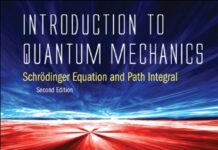
Ebook Info
- Published: 2004
- Number of pages: 536 pages
- Format: PDF
- File Size: 13.45 MB
- Authors: Harald J. W. Muller-Kirsten
Description
An extensive text on electrodynamics with detailed explanations and calculations. One hundred worked examples have been incorporated, making the book suitable also for self-instruction. Apart from all traditional topics of Maxwell theory, the book includes the special theory of relativity and the Lagrangian formalism and applications; the text also contains introductions to quantum effects related to electrodynamics, such as the Aharonov-Bohm and the Casimir effects. Numerous modern applications in diverse directions are treated in the examples.
User’s Reviews
Reviews from Amazon users which were colected at the time this book was published on the website:
⭐Recently, I wrote that textbooks on electromagnetism were poorly written and courses on the topic were poorly taught (a comment made when reviewing Vanderlinde’s textbook). I have not (yet) altered my position, but, I might add that this intermediate-level text almost compels me to alter that view. This text is similar to Vanderlinde (being detailed) yet different in other ways (no tensor methods). The level of difficulty lies between Griffiths (elementary) and Jackson (advanced). Muller-Kirsten makes the claim: “the text might also serve as a teach-yourself course in electrodynamics.” (preface). My opinion: That claim is merited.(1) MKS, those will be the units here utilized (not my preference). An appendix lists vector identities (however, derive those previous to study). There is a bibliography (an interesting selection) and footnotes. Do not ignore the footnotes ! For instance, a footnote (page 425) refers to an unpublished report by Fleming, “Noether’s Theorems.” Happily, that report can be readily discovered (downloaded) from the web. An appendix summarizes Dirac-delta function. However, understand that material before study of the text.(2) There are 21 chapters (first edition). As is traditional, the text begins with electrostatics. The plan: “we adopt the historical and phenomenological approach.” Section #2.5 contains Dirac-delta applications (through solved-problems). I emphasize the solved-problems throughout the book, they are invaluable. You could almost say that the solved-problems are the book (taking up half of the pagination). Often, solved-problems here are discovered to be student exercises in Jackson. Sometimes the solved-problems are relevant for research (page 21, #2.6 is utilized in Edward Witten’s 1998 paper “Anti-deSitter Space and Holography,” equation #2.18, page 12). Excellent pedagogic strategy !(3) Green (function) mentioned early (page 19), then systematically (chapter three). Minimize energy early (page 38). An infinite-product representation for hyperbolic-sine invoked (page 50). I highlight an interesting section: theoretical aspects of image charges (pages 53-65). Things are not always entirely theoretical: the solved-problem “measurement of electric susceptibility” is a nice example (page 105). It is worth remarking that Muller-Kirsten weaves mathematics and physics together in an interesting fashion.(4) One-hundred pages of electrostatics leads to magnetostatics (chapter five, page 109). I highlight: Ampere’s experiments and the law of Biot-Savart (pages 113-123). First instances of magnetic monopoles and gauge invariance here (page 123-125). You get a summary of formulas for electrostatics (page 106) and a summary of formulas for magnetostatics (page 150). Fast-paced, indeed ! A third of the text is behind us. Onward:(5) There is a nice selection of solved-problems regarding electromagnets (page 145). An interesting utilization of Gradshteyn’s tables (expansion of natural log of tangent, example 6.5, page 147). Read: “Today we are accustomed to the concept of fields already intuitively, so that the puzzles of long-ago lose their significance.” (page 159). I do not wholly agree with that statement. Students may read and use the word “field,” but that does not, however, imply a physical intuitiveness about it.(6) Another treat: Vector potential of long solenoid. An instance of gauge-transformation (page 182). Muller-Kirsten details a solved-problem (page 188, finite-length solenoid) which Jackson has given as a student exercise (page, 205, #5.2). It is plain to see that this book will assist with Jackson’s textbook !(7) Read: “In the literature, the Lenz rule is frequently–at least on first reading–difficult to follow.” (page 156). That is a statement I wholly agree with ! Electromagnetic waves, briefly (chapter nine). Encounter Green again (page 213), a solved problem utilizing contour integration. The detail presented in chapter ten (moving charges in vacuum) is useful for reading Oppenheimer’s lecture notes on electrodynamics and serves as supplement to Feynman (volume two–or, chapter nine of Garg).(8) My review, already too long. I touch on highlights: Born-Infeld Lagrangian invoked for a solved-problem (page 442, see Zwiebach, chapter twenty, for the relevance to string theory). A continuation of Green’s functions is here (relations to causality and dispersion relations, chapter sixteen). A footnote (page 377) referring to “an elementary method to calculate certain principle-value integrals” (1973, Caprasse), can be found online. An excellent chapter (seventeen) on covariant formulation (which does not utilize ict for ‘time-component’). An excellent section discusses “masslessness” for electromagnetic field (pages 434-446). A footnote refers to Freeman Dyson’s paper of 1990: Feynman’s proof of Maxwell’s Equations. All the more interesting because James L. Anderson wrote: “we conclude that the reconstruction given by Dyson is not a derivation of Maxwell’s equations.” (1990, American Journal of Physics). A nice discussion of Casimir effect concludes the book.(9) Concluding: An excellent contribution to the textbook literature. A mix of physics and mathematics, enlivened with detailed, solved, examples. The footnotes are informative. If J. David Jackson is opaque at any juncture, turn to this intermediate-book for assistance (although Jackson is aimed at graduate-level).An excellent resource, highly recommended.
⭐
Keywords
Free Download Electrodynamics: an introduction including quantum effects in PDF format
Electrodynamics: an introduction including quantum effects PDF Free Download
Download Electrodynamics: an introduction including quantum effects 2004 PDF Free
Electrodynamics: an introduction including quantum effects 2004 PDF Free Download
Download Electrodynamics: an introduction including quantum effects PDF
Free Download Ebook Electrodynamics: an introduction including quantum effects
